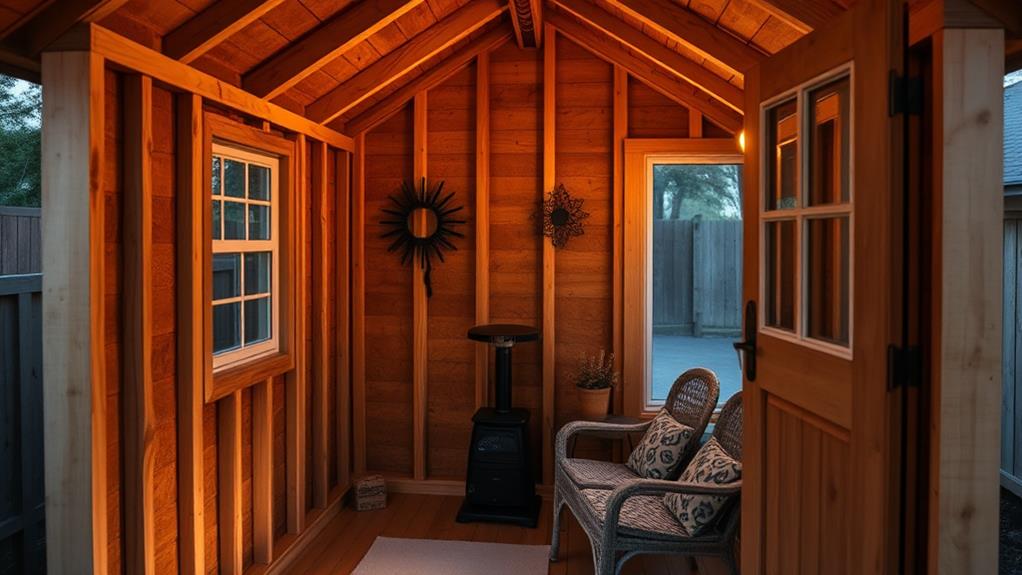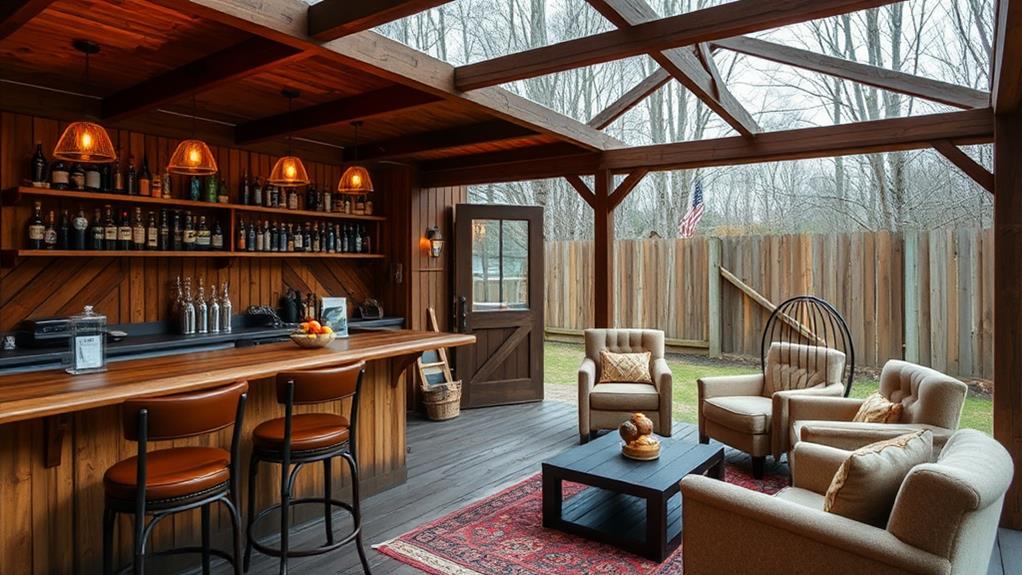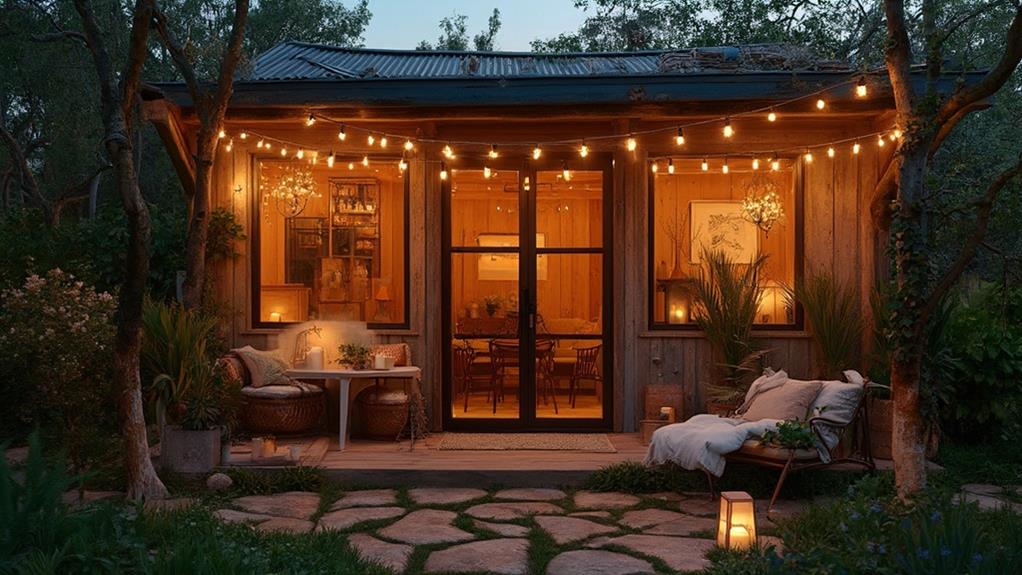Transforming outdoor sheds and basement spaces into stylish living areas maximizes property potential. Begin by assessing structural integrity, available space, and local regulations. Create a design plan that captures your desired aesthetic and functionality. Proper insulation and weatherproofing are crucial for comfort and longevity. Address electrical and plumbing needs, ensuring compliance with local codes. Furnish the space thoughtfully, balancing style and practicality. For shed conversions, focus on creating a cozy retreat. When building a basement bar, prioritize layout and atmosphere. With careful planning and execution, these often-overlooked spaces can become charming extensions of your home. Discover how to breathe new life into your property's hidden gems.
Assessing Your Shed's Potential

Before embarking on your basement bar project, it's crucial to thoroughly assess your shed's potential as a suitable space. Begin by evaluating the structure's integrity, including the foundation, walls, roof, and any existing insulation. Check for signs of water damage, mold, or pest infestations that may require remediation before proceeding.
Consider the available square footage and ceiling height to determine the layout possibilities for your bar area. Measure doorways and windows to ensure adequate ventilation and natural light. Assess the electrical capacity and plumbing accessibility, as these will significantly impact your design options and budget.
Examine local zoning laws and building codes to ensure compliance with regulations regarding the conversion of outdoor structures into living spaces. Obtain any necessary permits before starting work. Evaluate the shed's location relative to your home and neighbors, considering factors like noise levels and privacy.
Design Inspiration and Planning
With a clear understanding of your shed's potential, it's time to delve into the exciting phase of design inspiration and planning for your basement bar project. Begin by researching various bar styles and layouts that appeal to you, considering factors like seating capacity, storage needs, and overall ambiance. Create a mood board or digital collection of images that capture your desired aesthetic, whether it's a rustic pub feel, a sleek modern look, or a retro-inspired space.
Next, sketch a rough layout of your basement bar, taking into account the room's dimensions and existing features. Determine the placement of key elements such as the bar counter, seating area, and appliances. Consider functional aspects like traffic flow, lighting, and ventilation to ensure a comfortable and practical space.
Develop a realistic budget for your project, factoring in costs for materials, labor (if hiring professionals), and any necessary permits. Prioritize essential elements and identify areas where you can save money through DIY solutions or budget-friendly alternatives. Finally, create a timeline for your basement bar transformation, breaking the project into manageable phases to keep you on track and motivated throughout the process.
Insulation and Weatherproofing Essentials

Proper insulation and weatherproofing form the foundation of a comfortable and energy-efficient basement bar. Begin by assessing the existing insulation in your basement walls and floors. If inadequate, install rigid foam insulation or fiberglass batts to improve thermal performance. Pay special attention to rim joists and other potential air leak points.
Address moisture concerns by applying a waterproof sealant to concrete walls and floors. Install a vapor barrier beneath flooring materials to prevent moisture penetration. For added protection, consider a French drain system or sump pump if water intrusion is a recurring issue.
Ensure proper ventilation by installing an exhaust fan or dehumidifier to control humidity levels. This step is crucial for preventing mold growth and maintaining air quality. Weather-strip doors and windows to minimize drafts and improve energy efficiency.
Don't overlook soundproofing when insulating. Use acoustic panels or sound-dampening insulation to reduce noise transmission between the bar area and living spaces above. This consideration is particularly important if you plan to host lively gatherings or install audio equipment.
Electrical and Plumbing Considerations
Crucial electrical and plumbing considerations must be addressed when creating a basement bar. Electrical work should prioritize safety and functionality. Install GFCI outlets to protect against moisture-related hazards, and ensure adequate lighting with a combination of ambient and task fixtures. Consider adding dimmer switches for ambiance control. Plan for appliance power needs, including refrigerators, blenders, and ice makers.
Plumbing requirements depend on the bar's complexity. At minimum, install a bar sink with hot and cold water lines. Ensure proper drainage by connecting to existing plumbing or installing a new drain line. For more advanced setups, consider adding a dishwasher or ice maker, which require additional water lines. Install shut-off valves for easy maintenance and repairs.
Ventilation is crucial in basement spaces. Install an exhaust fan to remove moisture and odors. If planning to serve draft beer, factor in the need for CO2 lines and kegerator placement. Always consult local building codes and obtain necessary permits before starting electrical or plumbing work. Hiring licensed professionals for complex installations is recommended to ensure safety and code compliance.
Furnishing Your Transformed Space

Selecting the right furnishings for your basement bar can transform it from a simple renovation into a personalized entertainment space. Begin by choosing a bar counter that fits your available space and budget. Pre-fabricated options can be cost-effective, while custom-built counters offer unique designs. Pair the counter with comfortable bar stools that complement the overall aesthetic.
For seating areas, consider a mix of high-top tables with stools and cozy lounge furniture. Secondhand or upcycled pieces can add character while keeping costs down. Incorporate storage solutions like floating shelves or a repurposed bookcase to display glassware and bottles.
Lighting plays a crucial role in setting the ambiance. Install dimmable fixtures to create the right mood for different occasions. Add personal touches with artwork, vintage signs, or sports memorabilia that reflect your interests.
Don't forget functional elements like a small refrigerator, ice maker, and sink if your budget allows. A wall-mounted TV can provide entertainment during gatherings. Finally, invest in quality barware and glasses to complete the professional look of your basement bar.
Frequently Asked Questions
How Long Does a Typical Shed-To-Living Space Conversion Take?
The duration of a typical shed-to-living space conversion varies depending on the project's scope, complexity, and available resources. Generally, it can take anywhere from a few weeks to several months, with most projects averaging 4-8 weeks for completion.
Are There Zoning Restrictions for Converting Sheds Into Living Spaces?
Surprisingly, 43% of homeowners face zoning issues when converting sheds. Zoning restrictions for shed-to-living space conversions vary by locality. Many areas require permits, limit square footage, and enforce setback rules. Always check local regulations before starting your project.
Can I Convert a Metal Shed, or Only Wooden Ones?
Metal sheds can be converted into living spaces, but they present challenges. Insulation, climate control, and structural reinforcement are necessary. Wooden sheds are generally easier to modify, but with proper planning and expertise, metal sheds can be transformed successfully.
What's the Average Cost per Square Foot for a Shed Conversion?
The average cost for a shed conversion typically ranges from $50 to $150 per square foot, depending on factors such as materials, complexity, and location. However, DIY projects can significantly reduce expenses compared to professional renovations.
How Does a Shed Conversion Affect Property Value and Taxes?
Prepare for a jaw-dropping boost to your property value! A shed conversion can skyrocket your home's worth by up to 20%. However, be cautious—increased square footage may lead to higher property taxes. Consult local regulations for specific impacts.
Conclusion
Transforming a shed into living space offers a cost-effective way to expand usable square footage. With proper planning, insulation, and utility considerations, these once-neglected structures can become charming retreats or functional workspaces. As the adage goes, "One man's trash is another man's treasure," and this certainly applies to shed conversions. By reimagining outdoor storage, homeowners can create unique, personalized spaces that enhance property value and provide additional room for relaxation, creativity, or productivity without the need for extensive construction.

